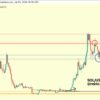
A Solana-based meme coin, SLERF, does not show similar performance as WIF, PEPE or even SHIB. Meme coins are known for their wild price swings and often rise, driven by fear of missing out (FOMO). SLERF seems to follow this pattern but does not generate any profit.
A Solana-based meme coin, SLERF, does not show similar performance as WIF, PEPE or even SHIB. Meme coins are known for their wild price swings and often rise, driven by fear of missing out (FOMO). SLERF seems to follow this pattern but does not generate any profit.
After losing a staggering 6,039 SOL (worth approximately $1.15 million), this trader sold all of his SLERF holdings at a loss. Without learning from the painful blow, they moved the remaining SOL to Binance. Just the day before, the same investor had experienced a loss of 2,793 SOL when purchasing SLERF with 1 million dollars in SOL.
When the price of SLERF rose again, the FOMO error appeared, leading the trader to buy three million SLERF at $1.17 each, costing him a whopping 19,133 SOL ($3.52 million) . You probably wouldn’t be wrong if you guessed that this venture was also unprofitable.
It is important to understand that meme coins are incredibly high risk due to their nature. They often start as a joke and lack fundamental support. Most meme coin investors who make returns are usually those with inside information, such as the creators, or those who use automated trading programs that can enter and exit trades much faster than humans, such as MEV robots or the snipers.
For the average investor, jumping into meme coins can often result in significant losses, especially the newer ones, without any liquidity. While there are stories of meme coin millionaires, they are the exception, not the rule.
It is advisable to tread carefully in the meme coin space. SLERF’s track record shows that it can be a portfolio destroyer, and getting involved without a solid strategy or internal knowledge could be setting yourself up for disaster.























